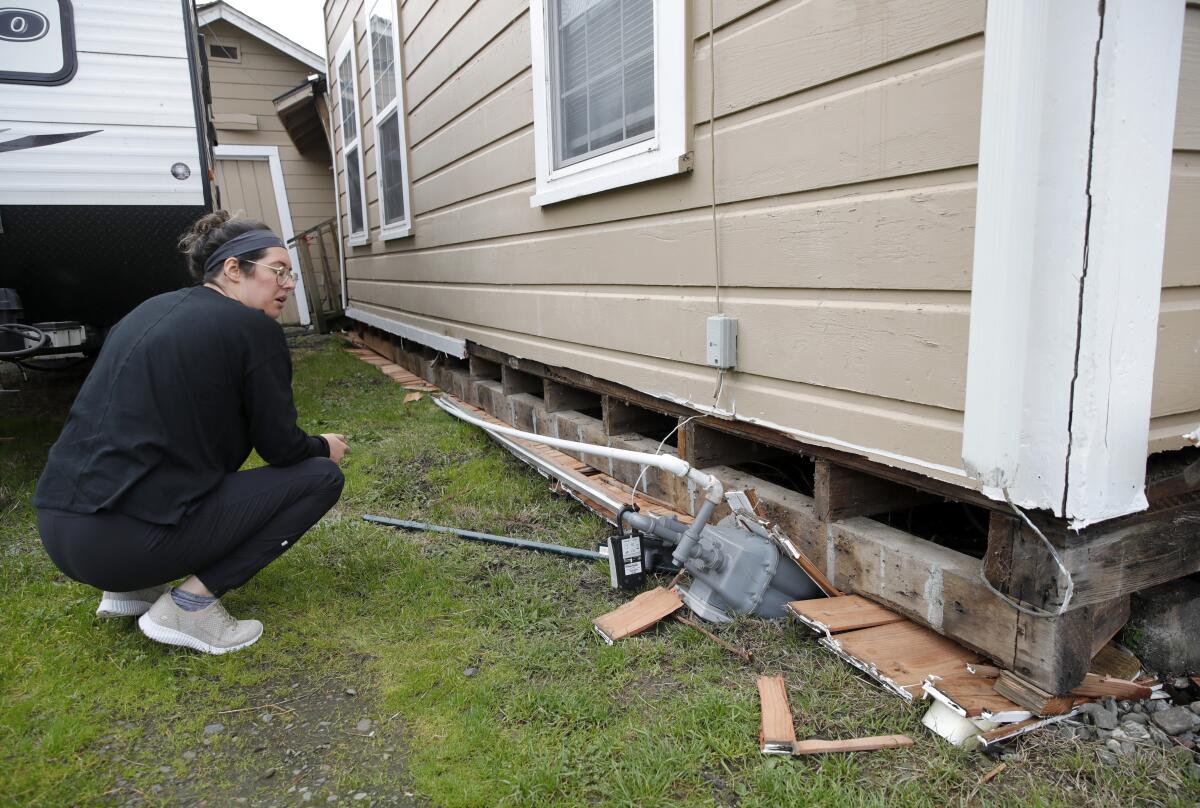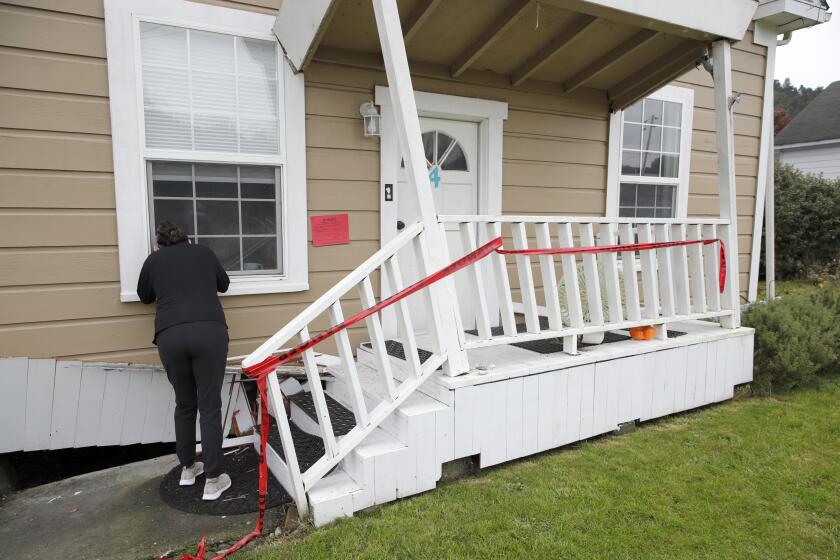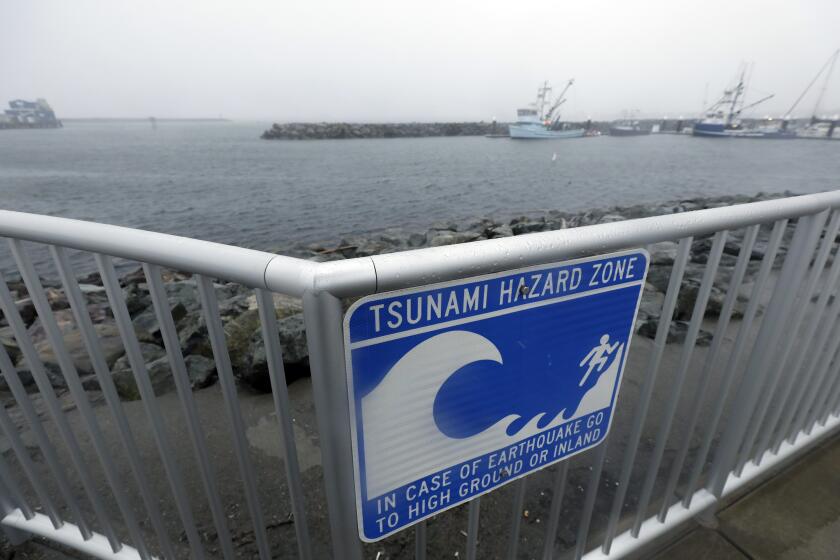Will your home survive a major quake? Free cash from California can help

- Share via
With more than a million California houses in need of seismic retrofitting, the California Earthquake Authority and the Governor’s Office of Emergency Services launched a program 10 years ago to cover at least part of the cost of shoring up the foundations of older homes in earthquake zones.
The brand new Earthquake Brace + Bolt program secured the foundations of nine houses in its first year — not a barnburner of a debut. But the point, said Janiele Maffei, was simply “to stand up the program, see if it works.”
It’s helping far more homeowners these days, having recently notched its 20,000th retrofitting, said Maffei, the earthquake authority’s chief mitigation officer. The EBB program typically offers a round of grants each year, usually opening the application window for a limited time in the fall.
At the moment, the program is offering a special round of grants to residents of Humboldt County, which has been hit by a series of quakes and powerful aftershocks over the last six months. Applications from eligible county homeowners will be accepted through July 31, Maffei said.
No date has been set for the next round of EBB funding for applicants in the rest of the state, but Maffei guessed that it will happen before the end of this year.
Here’s more information on how the program works, what it’s doing in Humboldt County, and how to be alerted for the next time grants are available.
The guide to earthquake readiness and resilience that you’ll actually use.
What does ‘brace and bolt’ mean?
The powerful ground movements caused by an earthquake can knock a house off its foundation, rupturing water and gas lines and rendering the structure unstable. If that happens to your house, local inspectors will “red tag” it, meaning they will forbid you to live there until repairs are made.
Houses built from 1980 on had to comply with building codes that make them less vulnerable in a quake. But if you’re in an older house with a raised foundation — the type with a crawl space between the ground and the underside of the main floor — the bulk of the house may not be attached firmly to the supports underneath it.
“Bracing” means shoring up the “cripple walls” that raise the house a few feet above the ground, adding boards between a cripple wall’s studs and covering the inside of the walls with a layer of plywood. The reinforcement helps hold the cripple walls together when the ground shakes violently.
“Bolting” means linking the wooden frame to the concrete foundation with thick metal fasteners, preventing it from being bounced off by a quake. Houses that sit right on top of their foundations also benefit from bolting.
According to the program, the average cost of a retrofit funded by EBB is about $5,500. How much it will cost to retrofit your house will depend on its size, as well as the condition of the foundation and cripple walls.
Earthquakes can drop in at the worst possible time. Jacqui and Shane McIntosh were about to sell their home when it was shattered by a 6.4 quake.
How does Earthquake Brace + Bolt work?
The program’s standard grant reimburses homeowners up to $3,000 for the work done to strengthen their foundation and secure their water heater. Lower-income households — those earning up to $72,080 a year — are eligible for a supplemental grant of up to $2,650 in Southern California and $7,000 in Northern California, which may be enough to cover the full cost of bracing and bolting a house.
The state won’t hand over the money, however, until the work has been completed and approved. That means you’ll have to cover the cost of the work up front unless you can find a contractor willing to wait for the grant money to arrive.
The program’s rules dictate which houses, retrofits and contractors are eligible. An eligible home must:
- Be built before 1980, on level ground or a slight slope.
- Be the primary residence of the person applying for the grant.
- Be located in a ZIP Code targeted by the program. Maffei said the ZIP Codes are those in the U.S. Geological Survey’s seismic hazard areas that have a high percentage of houses built before 1940.
- Have not had a previously completed a brace and bolt retrofit.
Homeowners must:
- Employ a contractor listed in the program’s directory or, if the cripple walls are no more than 4 feet high, perform the work themselves.
- Wait to be accepted into the program before obtaining a building permit for the retrofit.
- Do the work according to the seismic safety chapter of the California Existing Building Code or a standard retrofit plan, and pass a final inspection by the local building and safety department.
- Provide photos of their house pre-retrofit, along with plans for the work and other documentation, within 90 days. Work cannot start until the program approves these.
- Complete the work within six months of your documents being approved by EBB, if the grant is federally funded. Whether the grant is funded by the state or the feds, homeowners will need to supply photos, receipts and other proof that the work was done properly.
In sum, if you want to receive a grant, you’ll need to be accepted into the program before hiring anyone or obtaining a permit, provide the requisite proof that your house needs retrofitting, do the work promptly according to the state’s specifications, then show proof of the work and your expenses. That’s when you can be reimbursed (or your contractor can be paid).
Registration for the program is open now only to homeowners in Humboldt County. To be notified when sign-ups open for other earthquake hazard zones in the state, enter your email address on the EBB See If You Qualify page.
Southern California’s housing stock and propensity for earthquakes mean homeowners here need to pay special attention to foundations, chimneys and more. Here’s your guide to retrofitting.
More money for Humboldt County
Located near the Mendocino triple junction of tectonic plates, Humboldt County is susceptible to an unusual number of quakes. Making matters worse, many of the houses in the area have post and pier foundations, which use wooden posts or concrete piers to lift the first floor a few feet above the ground.
The pint-sized stilts provide ventilation for the foundation and hold the house above the moist ground, Maffei said. But in a strong quake, those supports can snap. It is “the worst possible performer” when it comes to seismic safety, she said.
The building code allows red-tagged homeowners to put these houses right back on their foundations, Maffei said, which just sets them up to fail again. That’s where the brace and bolt program comes in, offering grants that can be used to add a continuous concrete perimeter and bolted cripple walls to make the stilts more resilient in a quake.
Last fall, 169 Humboldt County homes registered for the program before the application window closed. Then the county was hit by the first in a series of strong quakes, a magnitude 6.4 temblor in the wee hours of Dec. 20. The quakes prompted the EBB program to offer another round just to homeowners in 13 ZIP Codes in Humboldt County.
The program’s grants cannot be used to repair a house that’s been knocked off its foundation, however. They can only be used to guard against future damage. So Humboldt County homeowners who’ve been red-tagged will need to complete the basic repair work before hiring contractors to build a stronger foundation.
To qualify for aid in Humboldt County, you’ll have to meet the EBB rules described above. You can check your eligibility and apply for a grant at the EBB website.
California is hit by about one tsunami a year, but most are barely noticeable. That said, if you live or work near the water or ever visit the coast, you should know what to do if there’s a big earthquake or a tsunami warning.
ICYMI: More California earthquake coverage
Scientists have a theory about why Southern California hasn’t experienced a major San Andreas fault earthquake in the past 300 years — a much longer gap than history would suggest is typical. It has to do with the Salton Sea drying up, but it comes with a warning: The dessicating lake can’t protect us from a major quake.
Does your home have living space above a garage? Scientists are warning that this common feature poses a risk of collapse during an earthquake. The risk is similar to that of apartment buildings where carports or garages on the ground floor are held up by weak columns. A number of cities, including Los Angeles and San Francisco, require these soft-story apartments to be retrofitted. But soft-story houses have flown under the radar.
Did you feel and hear it? Not the quake itself, but the early warning. Millions of Californians did. Depending on their distance from a December 2022 magnitude 6.4 earthquake near Ferndale in Northern California, people had up to 20 seconds of warning from their phones in what amounted to one of biggest real-world tests of the system. If you want an early warning, download the MyShake app.
Thank you for subscribing to Unshaken, The Times’ newsletter guide to earthquake readiness and resilience. More earthquake coverage >>
Get earthquake-ready in six weeks
From building a kit to buying insurance, our Unshaken newsletter course will help you prepare.
You may occasionally receive promotional content from the Los Angeles Times.







